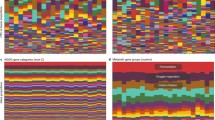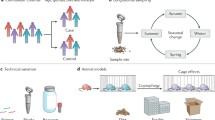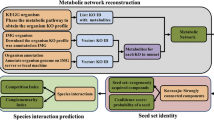Abstract
Microbiologists are transitioning from the study and characterization of individual strains or species to the profiling of whole microbiomes and microbial ecology. Equipped with high-throughput methods for studying the taxonomic and functional characteristics of diverse samples, they are just beginning to encounter the conceptual, theoretical, and experimental problems of comparing taxonomy to (micro-ecological) function, and extracting useful measures from such comparisons (i.e. diversity, stability, or “health”). Although still unresolved, these problems are well studied in macro-ecology (the ecology of non-microbes) and are reiterated here as an historical precautionary for microbial ecologists. Beyond expected and unresolved terminological vagueness, we argue that assessments and comparisons of taxonomic and functional profiles in micro-ecology suffer from theoretically unresolvable arbitrariness and ambiguities. We divide these into problems of scale, individuation, and commensurability. We argue that there is no technically/theoretically “correct” scale, individuation, or comparison of taxonomy and function, but there are nonetheless better and worse methodologies for profiling.



Similar content being viewed by others
Notes
Furthermore, as a reviewer pointed out, metagenomic gene catalogs do not capture gene interaction, thus further complicating the relation between gene presence and phenotypic expression.
References
Abubucker S, Segata N, Goll J, Schubert AM, Izard J, Cantarel BL, Rodriguez-Mueller B, Zucker J, Thiagarajan M, Henrissat B, White O (2012) Metabolic reconstruction for metagenomic data and its application to the human microbiome. PLoS Comput Biol 8:e1002358
Amend AS, Martiny AC, Allison SD, Berlemont R, Goulden ML, Lu Y, Treseder KK, Weihe C, Martiny JBH (2016) Microbial response to simulated global change is phylogentically conserved and linked with functional potential. ISME J 10:109–118
Amundson R, Lauder GV (1994) Function without purpose. Biol Phil 9:443–469
Apweiler R, Bairoch A, Wu CH, Barker WC, Boeckmann B, Ferro S, Gasteiger E, Huang H, Lopez R, Magrane M, Martin MJ, Natale DA, O’Donovan C, Redaschi N, Yeh LS (2004) UniProt: the universal protein knowledgebase. Nucleic Acids Res 32:115–119
Bäckhed F, Fraser CM, Ringel Y, Sanders ME, Sartour RB, Sherman PM, Versalovic J, Young V, Finlay BB (2012) Defining a healthy human gut microbiome: current concepts, future directions, and clinical applications. Cell Host Microbe 12:611–612
Bickle J (2016) Multiple realizability. In: Zalta EN (ed) The Stanford Encyclopedia of Philosophy (Spring). MIT Press, Cambridge
Blaser MJ (2014) Missing microbes: How the overuse of antibiotics is fueling our modern plagues. Henry Holt, New York
Budinich M, Bourdon J, Larhlimi A, Eveillard D (2017) A multi-objective constraint- based approach for modeling genome-scale microbial ecosystems. PLoS ONE 12:e0171744
Burke C, Steinberg P, Rusch D, Kjelleberg S, Thomas T (2011) Bacterial community assembly based on functional genes rather than species. Proc Natl Acad Sci USA 108:14288–14293
Cadotte MW, Carscadden K, Mirotchnick N (2011) Beyond species: functional diversity and the maintenance of ecological processes and services. J Appl Ecol 48:1079–1087
Cardinale BJ, Duffy JE, Gonzalez A, Hooper DU, Perrings C, Venail P, Narwani A, Mace GM, Tilman D, Wardle DA, Kinzig AP (2012) Biodiversity loss and its impact on humanity. Nature 486:59–67
Carmona CP, de Bello F, Mason NW, Lepš J (2016) Traits without borders: integrating functional diversity across scales. Trends Ecol Evol 31:382–394
Cordero OX, Polz MF (2014) Explaining microbial genomic diversity in light of evolutionary ecology. Nat Rev Microbiol 12:263–273
Cummins RC (1975) Functional analysis. J Philos 72:741–764
DeLaplante K, Picasso V (2011) The biodiversity-ecosystem function debate in ecology. In: DeLaplante K, Brown B, Peacock KA (eds) Philosophy of ecology. Elsevier, Oxford, pp 219–250
Dietert R (2016) The human superorganism: how the microbiome is revolutionizing the pursuit of a healthy life. Dutton, New York
Doolittle WF (1999) Phylogenetic classification and the universal tree. Science 284:2124–2128
Doolittle WF, Booth A (2017) It’s the song, not the singer: an exploration of holobioisis and evolutionary theory. Biol Philos 32:5
Doolittle WF, Zhaxybayeva O (2009) On the origin of prokaryotic species. Genome Res 19(5):744–756
Dussault AC, Bouchard F (2017) A persistence enhancing propensity account of ecological function to explain ecosystem evolution. Synthese 194:1115–1145
Elton CS (1958) The ecology of invasions by animals and plants. Chapman & Hall, London
Enright MC, Robinson DA, Randle G, Feil EJ, Grundmann H, Spratt BG (2002) The evolutionary history of methicillin-resistant Staphylococcus aureus (MRSA). Proc Natl Acad Sci USA 99:7687–7692
Gagic V, Bartomeus I, Jonsson T, Taylor A, Winqvist C, Fischer C, Tscharntke T (2015) Functional identity and diversity of animals predict ecosystem functioning better than species-based indices. Proc R Soc Lond B Biol Sci 282:20142620
Green JL, Bohannon BJM, Whitaker RJ (2008) Microbial biogeography: from taxonomy to traits. Science 320:1039–1043
Hanson CA, Fuhrman JA, Homer-Devine MC, Martiny JB (2012) Beyond biogeographic patterns: processes shaping the microbial landscape. Nat Rev Microbiol 10:497–506
Huddleston JR (2014) Horizontal gene transfer in the human gastrointestinal tract: potential spread of antibiotic resistance genes. Infect Drug Resist 7:167–176
Human Microbiome Project Consortium (2012) A framework for human microbiome research. Nature 486:215–221
Hurlburt S (1971) The nonconcept of species diversity: a critique and alternative parameters. Ecology 52:577–586
Ives AR, Carpenter SR (2007) Stability and diversity of ecosystems. Science 317:58–62
Jax K (2010) Ecosystem functioning. Cambridge University Press, Cambridge
Justus J (2011) A case study in concept determination: Ecological diversity. In: DeLaplante K, Brown B, Peacock KA (eds) Philosophy of ecology. Elsevier, Oxford
Kanehisa M, Goto S (2000) KEGG: Kyoto encyclopedia of genes and genomes. Nucleic Acids Res 28:27–30
Kanehisa M, Sato Y, Kawashima M, Furumichi M, Tanabe M (2016) KEGG as a reference resource for gene and protein annotation. Nucleic Acids Res 44:457–462
Krause S, Le Roiux X, Niklaus PA, Van Bodegom PM, Lennon JT, Bertilsson S, Grossart H-P, Philipott L, Bodelier PLE (2014) Trait-based approaches for understanding microbial biodiversity and ecosystem functioning. Front Microbiol 5:251
Kuhn TS (1976) The structure of scientific revolutions (Chicago, 1962)
Land M, Hauser L, Jun SR, Nookaew I, Leuze MR, Ahn TH, Karpinets T, Lund O, Kora G, Wassenaar T, Poudel S, Ussery DW (2015) Insights from 20 years of bacterial genome sequencing. Funct Integr Genom 15:141–161
Langille MGI, Zaneveld J, Caporoso JG, McDonald D, Knights D, Reyes JA, Clemente JC, Burkepile DE, Vega Thurber RI, Knight R, Beiko RG, Huttenhower C (2013) Positive functional profiling of microbial communities using 16S marker gene sequences. Nat Biotech 31:814–821
Louca S, Parfrey LW, Doebeli M (2016) Decoupling function and taxonomy in the global ocean genome. Science 353:1272–1277
MacArthur RH (1955) Fluctuations of animal populations, and a measure of community stability. Ecology 36:533–536
Maclaurin J, Sterelny K (2008) What is biodiversity?. University of Chicago Press, Chicago
Manor O, Borenstein E (2017) Systematic characterization and analysis of the taxonomic drivers of functional shifts in the human microbiome. Cell Host Microbe 21:254–267
Martiny JBH, Bohannon BJM, Brown JH, Colwell RK, Fuhrman JA, Green JL, Horner-Devine MC, Kane M, Krumins JA, Kuske CR, Morin PJ, Naeem S, Øvreas L, Reysenbach A-L, Smith VH, Staley JT (2006) Microbial biogeography: putting microorganisms on the map. Nat Rev Microbiol 4:102–112
Martiny AC, Treseder K, Pusch G (2013) Phylogenetic conservatism of functional traits in microorganisms. ISME J 7:830–838
Mason NW, Mouillot D, Lee WG, Wilson JB (2005) Functional richness, functional evenness and functional divergence: the primary components of functional diversity. Oikos 111:112–118
May RM (1973) Stability and complexity of model ecosystems. Princeton University Press, Princeton
McGill BJ, Enquist BJ, Weiher E, Westoby M (2006) Rebuilding community ecology from functional traits. Trends Ecol Evol 21:178–185
Meyer KM, Klein AM, Rodrigues JLM, Nüsskein K, Tringe SG, Mirza BS, Tiedje JM, Bohannonn BJM (2017) Conversion of Amazon rainforest to agriculture alters community traits of methane-cycling organisms. Mol Ecol 26:1547–1556
Mikkelson GM (1997) Methods and metaphors in community ecology: the problemof defining stability. Perspect Sci 5:481–498
Mlambo MC (2014) Not all traits are ‘functional’: insights from taxonomy and biodiversity-ecosystem functioning research. Biodivers Conserv 23:781–790
Mossio M, Saborido C, Moreno A (2009) An organizational account of biological functions. Br J Philos Sci 60:813–841
Naeem S (2002) Ecosystem consequences of biodiversity loss: the evolution of a paradigm. Ecology 83:1537
Naeem S, Wright JP (2003) Disentangling biodiversity effects on ecosystem functioning: deriving solutions to a seemingly insurmountable problem. Ecol Lett 6:567–579
Nunes-Neto N, Moreno A, El-Hani CN (2014) Function in ecology: an organizational approach. Biol Philos 29:123–141
O’Malley M (2008) ‘Everything is everywhere: but the environment selects’: ubiquitous distribution and ecological determinism in microbial biogeography. Stud Hist Philos Biol Biomed Sci 39:314–325
Odum EP (1953) Fundamentals of ecology. Saunders, Philadelphia
Ouzounis CA, Coulson RM, Enright AJ, Kunin V, Pereira-Leal JB (2003) Classification schemes for protein structure and function. Nat Rev Genet 4:508–519
Pavlicev M, Cheverud JM (2015) Constraints evolve: context dependency of gene effects allows evolution of pleiotropy. Annu Rev Ecol Evol Syst 46:413–434
Petchey OL, Gaston KJ (2006) Functional diversity: back to basics and looking forward. Ecol Lett 9:741–758
Petersen C, Round JL (2014) Defining dysbiosis and its influence on host immunity and disease. Cell Microbiol 16:1024–1033
Pimm SL (1980) Food web design and the effect of species deletion. Oikos 35:139–149
Prakash T, Taylor TD (2012) Functional assignment of metagenomic data: challenges and applications. Brief Bioinform 13:711–727
Raymond J, Siebert JL, Staples CR, Blankenship RE (2004) The natural history of nitrogen fixation. Mol Biol Evol 21:541–554
Riley MA (1998) Molecular mechanisms of bacteriocin evolution. Annu Rev Genet 32:255–278
Rison SC, Hodgman TC, Thornton JM (2000) Comparison of functional annotation schemes for genomes. Funct Integr Genom 1:56–69
Ronimus RS, Morgan HW (2001) The biochemical properties and phylogenies of phosphofructokinases from extremophiles. Extremophiles 5:357–373
Sarkar S (2007) From ecological diversity to biodiversity. In: Hull D, Ruse M (eds) Cambridge companion to the philosophy of biology. Cambridge University Press, Cambridge
Shapiro BJ, Leducq J-B, Mallet J (2016) What is speciation? PLoS Genet 12:e100
Sober E (1993) The nature of selection: evolutionary theory in philosophical focus. University of Chicago Press, Chicago
Stulberg E, Fravel D, Proctor LM, Murray DM, LoTempio J, Chrisey L, Graber J, Harris MC, Jackson S, Mishkind M, Porterfield M, Records A (2016) Am assessment of US microbiome research. Nat Microbiol 1:1–7
The Human Microbiome Consortium (2012) Structure, function and diversity of the healthy human microbiome. Nature 486:207–214
Tilman D, Downing JA (1994) Biodiversity and stability in grass-lands. Nature 367:363–365
Tilman D, Wedin D, Knops J (1996) Productivity and sustainability influenced by biodiversity in grassland ecosystems. Nature 379:718–720
Tringe SG (2005) Comparative metagenomics of microbial communities. Science 308:554–557
Turnbaugh PJ, Hamady M, Yatsunenko T, Cantarel BL, Duncan A, Ley RE, Sogin ML, Jones WJ, Roe BA, Affourtit JP, Egholm M (2009) A core gut microbiome in obese and lean twins. Nature 457:480–485
Wilson GA, Bertrand N, Patel Y, Hughes JB, Feil EJ, Field D (2005) Orphans as taxonomically restricted and ecologically important genes. Microbiology 151:2499–2501
Wright L (1973) Functions. Philos Rev 82:139–168
Wright JP, Naeem S, Hector A, Lehman C, Reich PB, Schmid B, Tilman D (2006) Conventional functional classification schemes underestimate the relationship with ecosystem functioning. Ecol Lett 9:111–120
Acknowledgements
We thank Adam Martiny and an anonymous reviewer for Biology and Philosophy for their very helpful comments. G.M.D. is supported by an NSERC Alexander Graham Bell Canada Graduate Scholarship. W.F.D. is supported by an NSERC Herzberg Medal Grant. M.G.I.L. is supported by an NSERC Discovery Grant.
Author information
Authors and Affiliations
Corresponding author
Rights and permissions
About this article
Cite this article
Inkpen, S.A., Douglas, G.M., Brunet, T.D.P. et al. The coupling of taxonomy and function in microbiomes. Biol Philos 32, 1225–1243 (2017). https://doi.org/10.1007/s10539-017-9602-2
Received:
Accepted:
Published:
Issue Date:
DOI: https://doi.org/10.1007/s10539-017-9602-2




